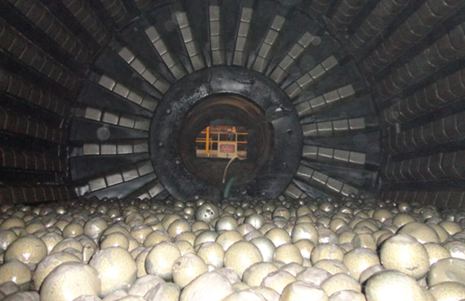Every grinding mill lining application has different characteristics that require unique solutions to optimize mill performance and liner life. Mill liners have historically been made either of rubber or steel. Composite mill liners combine the benefits of steel liners with the flexibility of rubber liners. Below we will explain key advantages to composites.
Advantage #1—Composite liners are lightweight
Composites can be up to 35-45% lighter than metal liners. This can provide an opportunity to design larger, fewer components. This can lead to a faster, safer installation.
Advantage #2—Composite liners resist pegging and peening
When using composites, suppliers have the flexibility to design liners with less components. This reduces the number of joints between liners, and minimizes joint gaps. Steel liners are susceptible to peening caused by impacts from the grinding balls. Removal of the balls often involves hammering to dislodge the liners, and possibly gouging the joints using a cutting torch. Using composites can eliminate these unsafe and time consuming maintenance. Composite liners have a better fit than steel, and the rubber joints eliminate peening, making removal much easier. Another advantage of the improved joint fit is the elimination of material entering the joints and causing damaging raceways and lockups of ore particles.
Advantage #3 –Composite liners have a shorter delivery time
Composites are quicker to manufacture, which means shorter lead times. Mining companies will have more flexibility when placing orders. It reduces the need for ordering early and the risks associated with having mill liners stored on-site longer than necessary.
Advantage #4—Composite liners increase throughput
Lighter liners can be optimized to increase mill volumetric capacity, throughput and operational revenues. Mills with charge mass limitations can benefit from lighter composite mill linings that allow more material to be fed to the mill without exceeding mass limits. Also, the increased wear life offered with composites may allow the OEM to reduce the thickness of the liners. This results in an increase in volumetric capacity allowing more material to be fed into the mill. This provides an opportunity to increase mill throughput, resulting in increased revenue for the mine.
Liner design can have a dramatic impact on both mill availability and grinding efficiency. By optimizing the design through materials of construction, significant improvements can be made to not only enhance wear resistance but also to reduce relining times, getting the mill back on-line sooner.
Interested in learning more? Jasper Engineering will be hosting a webinar on Weir’s Composite Mill Liner system in January 2021. Email us if you would like to be included on the invitation. Contact Jasper Engineering today at (218) 262-342 or (952) 938-6504, or email us at sales@jaspereng.com.

